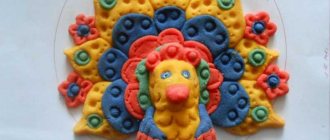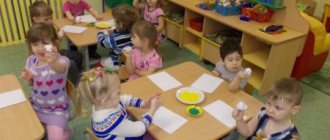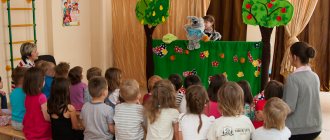Summary of a game lesson - experimentation in the senior group
Summary of a game lesson - experimentation for older children “Is the air hot?”
The summary may be useful for teachers of senior kindergarten groups, parents who are interested in developing the cognitive activity of their children, and those who want to experimentally introduce children to the properties of natural phenomena.
It can be used in a series of educational and play activities to introduce children to the properties of air. Goal: development of cognitive activity of children. Objectives: To introduce children to the “ability” of air to expand when heated.
• Intensify the use of quality adjectives in speech and practice formulating a question using these adjectives. • Clarify children’s knowledge of the game “table tennis”, expand their understanding of how to play with a tennis ball, and exercise their ability to form cognate verbs with various prefixes. • Remind safety rules when working with hot water. • Continue to develop the ability and desire to sketch an experiment, as one of the methods for developing motor (motor) and visual memory. • Foster a caring attitude towards toys. Progress of the lesson.
Educator:
They reluctantly learn their lessons Chatterboxes and couch potatoes Inquisitive children They want to know everything in the world! Why are there clouds in the sky? Why are hedgehogs prickly? Why does a snowflake melt when it reaches your palm? Why do dunes crawl? Why are there fogs? Why have the land and the sea been in dispute with each other for a whole century? Why did the star fall? Why do I know little? Apparently you shouldn’t be lazy, but study and study! A lot of questions “why”, “how”, “it happens - it doesn’t happen” arise among inquisitive children. And this is very good. What should you do to get answers to all these questions? Children: Read in the book. Ask adults. Educator: Correct. You can also experiment. And today it is an experiment that will help you and I learn something interesting about one familiar natural phenomenon. Guess which one: It goes through the nose into the chest and goes back on its way.
He is invisible, but still we cannot live without him. Children: About the air?!
Educator: Yes. When the sun shines outside, you and I feel hot. Do you think the air can be hot? Children: ... Educator: An object hidden in my wonderful bag will help us answer this question. What kind of object is this you will now try to guess. Let's play the Yes-No game. Look at the screen. On the screen there is an algorithm for describing the object: 1. Crossed out geometric shapes: circle, rectangle, triangle. 2. hand. 3. scales. 4. pictures of pieces of material: wood and fabric (fur). 5. a picture depicting the figures of mom, dad and children. The algorithm will tell you what to ask about the hidden item. The question must be formulated in such a way that I can only answer “yes” or “no.” You cannot ask about the shape of an object. You can ask: what does it feel like, light or heavy, what material is it made of and how you can play with it. The game "Yes - no" is played. Child: Is this item soft? Educator: No. Child: Is it hard? Educator: Yes. Child: Is this object smooth? Educator: Yes. Child: Is the object heavy? Educator: No. Child: So it’s easy? Educator: Yes. Child: Is it wooden (metal, glass)? Educator: No. Child: Is it a plastic object? Educator: Yes. Child: He can ride (fly). Educator: No. Child: Can he jump (roll)? Educator: Yes. Child: This is a ball Teacher: You guessed correctly. It's a ball! (Show)
Tennis ball!
What is the name of the game in which such a ball is used? Child: Table tennis. Show a picture of the game on the screen. Educator: Correct. This game is called table tennis because it is played on a table. Review and discussion of the rules of the game. Educator: And if we don’t have a tennis table, is there another way we can play with the ball? Children: You can just throw up and catch, you can throw and catch from the wall, you can throw from hand to hand, like jugglers in the circus, you can just learn to hit with a racket. Educator: You can also... make a goal and play football. By the way, a very useful exercise for developing breathing. On the screen: a photograph of children playing football. Educator: Let's see what other exercises we haven't named. On the screen is a table with schematically drawn possible game options. Children with a teacher: The ball can be tossed, thrown to each other, rolled into collars, blown on the ball, knocking down the target, thrown and caught from the wall, hit with a racket, rolled. But you can't play with your feet. Educator: What qualities do these exercises develop? Children: Dexterity, patience (after all, not everything will work out right away, you need to practice), development of fingers so that they can write well at school... A physical education session, during which children try to play with a ball. Educator: Well done, you tried to play with the ball. Tell me, please, why can we blow on a ball and move it from its place? Children: Because it is light. Educator: Why is it so light? Children: Because he has air inside. Educator: Correct. Let's remember what we already know about air and play the game “It happens - it doesn’t happen.” The rules are as follows: 1. The one to whom I throw the ball can answer the question; 2. “yes” and “no” cannot be said. The game “It happens - it doesn’t happen” is played.
•
Is the air warm? (Happens). • Is the air clean? (Happens). • Is the air fluffy? (Can not be). • Is the air light? (Happens). • Is the air dirty? (Happens). • Is the air angry? (Can not be). • Is the air sometimes cold? (Happens). • Is the air streaky? (Can not be). • Is the air hot?(…). Educator: We will try to find the answer to this question today. And a tennis ball will help us with this. Not from our “wonderful bag,” but this one. Showing a “first aid kit” (a box with a medical cross) containing a tennis ball with a dent. Educator: Someone mistreated the ball. Maybe he played incorrectly (with his foot, for example) or stepped on it. Look what happened to him. Children: Dent! Educator: What to do now, how to fix the ball? Try it, maybe someone will be able to “fix” it. The children try to straighten the dent, but nothing works. Educator: What if we wash the ball, maybe that will fix it? Children: No!!! Educator: Maybe it will still help? Remember, as in the fairy tale by Korney Chukovsky: Oh, you, my poor orphans, My irons and frying pans! Come home, unwashed, I will wash you with spring water. I will clean you with sand, I will douse you with boiling water, and you will again shine like the sun. Let's try to “drench” our ball with boiling water? So my kettle just boiled. Just let's remember the safety rules: you can burn yourself with boiling water and get a burn (those big blisters on the skin, very dangerous and painful). Therefore, children should not use a freshly boiled kettle on their own: disaster could happen. We need to ask adults for help. If you are using a regular jar and not a glass, then before pouring boiling water, you need to put a spoon in it, because the jar may burst from very hot water. The experiment must be carried out on a tray for safety. If water suddenly spills, it will be on the tray and will not scald you. Today I will be your assistant. I will put our “sick” ball in a glass and, holding it with a spoon so that it does not “jump out,” I will carefully pour hot (!!!) water. Ready! Count to five. Children: One, two, three, four, five.
Educator: I carefully take out the ball... Look... Where did our dent disappear to? Where did she go? Miracles! Children: There’s no dent?! Educator: Yes, the dent has disappeared. Where? What happened when we poured boiling water into a glass? Children's suggestions are listened to. Educator: Inside our ball, as we know, there is air. This air from the hot water began to heat up, it became hot and it began to move apart and put pressure on the walls of the ball and straightened it. This property of air is referred to as “air expands.” So you and I found out that it turns out that the air also “gets hot”, and at the same time it expands. Let us, like real scientists, record such an important discovery. Take pieces of paper and pencils. Now we will remember what we did. Sketch of the experiment. Educator: Draw a ball. Try to keep it the same size as a real one. (We develop our eye). There is a dent on the ball, draw such an uneven spot. Next we draw a glass (there is a ball with a dent in it) and a teapot with boiling water pouring from the neck. Steam is coming out of the kettle spout. And then - a spoon with a ball, but without a dent. Educator: Today we made a small discovery: we learned that the air “gets hot,” that is, we learned that air expands when heated. We helped the ball become necessary and useful again. Now this ball can also be used for playing. But I have a big request for you: please remember that children should not play with boiling water or use a hot kettle on their own. And now I’ll show you another “trick”. It’s called a “living balloon”. Demonstration of the “Balloon Comes to Life” experiment. A balloon is placed on the neck of a glass bottle (the balloon hangs down). The bottle is placed in a metal container into which boiling water is poured. The air heated in the bottle expands, there is little room for it, and it “transitions” into the ball, lifting it (the ball “stands up”). The experiment is carried out on a tray. Educator: Our magic bag has prepared gifts for you all - tennis balls. Play with them, exercise and take care of them.
We recommend watching:
Summary of experimental activities in the senior group Summary of GCD in the middle group with elements of experimentation Search - research activities in kindergarten. Senior - preparatory group Entertainment scenario for children of the middle group
Similar articles:
Experiments on the topic “Air” in the senior group
Summary of a mathematics lesson in the senior group of kindergarten. Geometric figures
Summary of experimental activities in the senior group “Invisible Air”
Summary of experimental activities in the senior group
"INVISIBLE AIR"
Target:
develop children's cognitive interest in the process of experimenting with air.
Tasks:
Cognitive development:
- Develop cognitive activity and curiosity;
- Give an idea that air has properties: air is invisible, air is odorless; and also give an idea that wind is the movement of air;
- To promote mastery of various ways of detecting air (you can catch it, feel it);
- Learn how to conduct simple experiments with air;
- To form the foundations of an ecological culture, to cultivate a caring attitude towards the world around us, and a desire to explore it in all available ways.
Speech development:
Expand and activate children's vocabulary, develop coherent speech, enrich vocabulary: sailboat, atmosphere.
Social and communicative development:
Form partnerships among children in the process of research activities, the ability to work together.
Artistic and aesthetic development:
Develop attention, imagination, observation.
Form of study:
research and cognitive activities of children of the older group.
Amount of children:
subgroup.
Progress of educational and research activities:
-Guys, let's stand in a circle and greet each other.
We speak in unison.
-Hello, my friend,
Hello, my friend!
Hurry up and join me in a circle! Let's smile and say, "Hello!" To the sun: “Hello!”
And to all of us: “Hello”! We pass to each other in a circle: good morning Irina, etc.
- Guys, you asked me today: “What is this surprise in our group?” Want to know what it is? (Yes) Let's see. Guys, what is this? (Balloon, Dunno) What was he going to do? (Fly) Well, should we let Dunno fly? (Yes) Let's launch the ball.
- Guys, what happened? (The ball deflated) Will Dunno continue his flight? (Answers) Why? (Children's answer options, for example, the air has run out in the balloon) - Guys, do you know what air is? (No, yes) - But Dunno doesn’t know what air is and asks you to tell him about it. (Answers) - There is air around us and around the entire earth. It envelops the earth like a thick blanket. It's called atmosphere. What is his name Dima? Ask a few kids. Every living thing on earth breathes air. Plants and animals breathe air, and you and I cannot live without air. Place your hands on your stomach, inhale - draw in your stomach, exhale - inflate your stomach. Try holding your breath for a minute. How do you feel? Imagine what would happen if the Earth lost air? (answers) You see, guys, how important it is to have air.
-Why do you think air is called invisible? (It's invisible) Yes, it's transparent and we don't see it, but it's there. Do you know what other properties air has? (Answers) But Dunno doesn’t know. Who can help Dunno? (Answers) How can you help him? Remember, when you and I learned the properties of water, who did we turn into? (In scientists). - Let us turn into scientists again today and explore the air. And then we will be able to tell Dunno what this air is like. What do we need to do to become scientists? (Put on aprons) Where should we go to explore the air? (To the laboratory) What is a laboratory? (Answers) How should you work in the laboratory? Get to your seats.
Experience 1.
(standing)
Equipment:
Cellophane bags for each child.
- Guys, do you want to try to catch the air and see it? – You have bags and try to catch the air with them. Do you think it will work? Open the bag and make several wave-like movements. Then quickly close the bag. What do we see? (The package inflated)
-What do you have inside the package, there was nothing around us? (Air)
- What is this air like? (Transparent)
- Well done, that's right. You see, air is invisible, but we can catch it.
- Let's release the invisible man. Open the package. Set the bags aside.
What can we conclude? The air is clear.
-What needs to be done to see it? (You have to catch him to see him)
- We will indicate that the air is transparent and can be caught with this sign. (Show the sign and give it to the child who answers) Take care of it.
Experience 2.
Equipment:
glasses with a strip of paper glued, large glasses for each child.
- Guys, you can sit down now.
Take in your hands a small glass, inside of which there is a strip of paper glued to plasticine. Look carefully, what kind of strip of paper is it? (dry) Touch it. Turn the glass upside down and slowly lower it into a large glass of water. The glass must be held straight. What do you think will happen? (The paper will become wet) Continue immersing the glass in the water until it touches the bottom. Then remove the glass from the water and check the paper strip again. Is she wet or not? Why did the paper remain dry? (Answers)
- Guys, there is air in the glass, and it does not let water in. Air is everywhere, we don’t see it, but it is in all empty volumes.
What can we conclude?
Air is everywhere and it takes up space.
We will denote the fact that air occupies all empty volumes with this sign. (Show the sign and give it to the child) Take care of him.
Experience 3
.
Equipment:
One basin of water on the table (4 pieces), a sheet of paper, boats (4 pieces).
- Guys, how can you feel the air? (Inhale) What else? What if you try to wave? What will happen? How will you feel? (Wind, air) In very ancient times, people used a fan to keep them warm. Let each of you try to make your own fan. (Children fold leaves and make fans). If you fan, how do you feel? (breeze). How did this breeze come about? The fan moves and, as it were, pushes the air, makes the air move. The air also begins to move. Wind is the movement of air. Guys, what replaces a fan in our lives? (Fan)
What can we conclude?
Wind is the movement of air.
We denote that wind is the movement of air with this sign. (Show the sign and give it to the child) Take care of him.
- Guys, you have boats. Look, what's special about these boats? (Sail) Such ships are called sailboats. What are these ships called? Ask a few kids. Put these ships in the water and see what happens. (Nothing) What needs to be done to make the sailboat float? (Blow, wave) That's right. Give it a try. So, what helps a sailboat sail? (Wind) But the wind does not help all ships, but only which ones? (The wind helps sailboats)
- Guys, the wind can be a helper for a person, it is the wind that brings benefits. We will denote it with this picture. And sometimes the wind is a destroyer that causes harm. We will denote it with this picture. Now, we will try to figure out in which situations the wind helps and in which it causes harm. Let's get up and go to the table.
Didactic game “Which wind?”
Goal: to consolidate children’s knowledge about the phenomena of inanimate nature, the properties and types of wind.
Game rules: determine the positive or negative properties of the wind.
Game actions: Children look at the plot pictures and determine what kind of wind is depicted on them.
Didactic material: story pictures about the wind.
Progress of the game.
The teacher displays pictures of the wind on a magnetic board (good wind, evil wind). Children must determine where the wind is beneficial and where it is harmful.
— A sailing ship.
— The children are flying a kite.
— Strong wind in the forest and swaying trees.
— There is a strong wind outside, and the children are walking in the yard. (- Is it possible to walk outside during strong winds? It’s unsafe.)
Children glue the story pictures to the corresponding wind pictures on the board and explain why they did this.
“That’s how different the wind is, but now think about what the wind can be like?”
(Strong, weak, pleasant, affectionate, quiet, cool, warm, refreshing, gentle, pleasant, fast, sharp, unnoticeable)
- Well done boys. They explained to Dunno what the wind could be like.
What can be concluded?
Wind can be beneficial and wind can be harmful. (Give the signs to the children).
Experience 4.
Equipment:
chopped orange, lemon, garlic, perfume.
- Guys, while you were playing, Dunno asked me, does the air have its own smell? Take a deep breath. Did you smell it? Do you want to play the game “Recognize by smell” (Yes) But first, let’s remember how to inhale smells? How should the air be directed? (Careful, use your hand to direct the air flow) Then, come here, close your eyes and don’t peek. (Children are asked to guess the smell of orange, perfume, garlic with their eyes closed) - What smell did you smell? (Children's answers) Let's move on. (Go to 4 places)
— Does the air have its own smell? (No) - What can air do? What can air transmit? (Air can transmit odors.) - Well done, right. The air carries the smell of the substance that I suggested you smell.
What can we conclude
? Air does not have its own odor; air can transmit the odor of another substance.
We will denote the fact that the air does not have its own smell with this sign. (Show the sign and give it to the child). Take your seats.
Experience 5.
Equipment:
Candle on stand, glass lid, lighter. - Guys, what is this? (Candle) Let's light it and see what happens. I light a candle. The flame is burning.
— Can it pollute the air? (Answers) Hold the glass lid over the candle flame (at a distance of 1-2cm). After some time, we will see that this object has turned black from below - covered with a layer of soot.
- Guys, what's on the lid? (Dirt) You saw that even such a small flame can contaminate the lid. And if it contaminates the lid, what else does it contaminate? What is around us? (Air) That's right, burning flames pollute the air.
— Tell us, what else pollutes the air in our lives?
Children's answers: smoke from factories, fires, garbage dumps, cigarette smoke, cars.
— What helps purify the air? Plants and factories install special filters that purify the air; Plants are important air purifiers and air purifiers.
What can be concluded?
The air is polluted, but it can be purified.
We will indicate that the air is being polluted with this sign. And the fact that the air can be purified is so because the main air purifiers are plants. (Show signs and give to children who do not have signs).
Guys, what did we talk about today? (about air).
— Look at your signs-symbols, what properties of air do they represent? Irina, what is your ability? Please glue your property onto a sheet of paper in the designated place. Ask everyone. Children list the properties of air and go to glue their signs on sheets of paper.
- Guys, why did we study the air? Who did we help learn about air today? (Dunno) So that Dunno today does not forget what we learned about air, we will make a gift for him. The teacher bends the ends of the sheet and gets a pinwheel.
— Guys, there is one more interesting property of air, you can play with it. They even sell air toys. And you and I made such a toy ourselves. This is a fidget spinner toy. (Show: blow on the resulting pinwheel.) We will give it to Dunno so that he will not be upset that he could not fly.
- That's how much we learned about air today. Our study is over, please clear away your workspaces.



